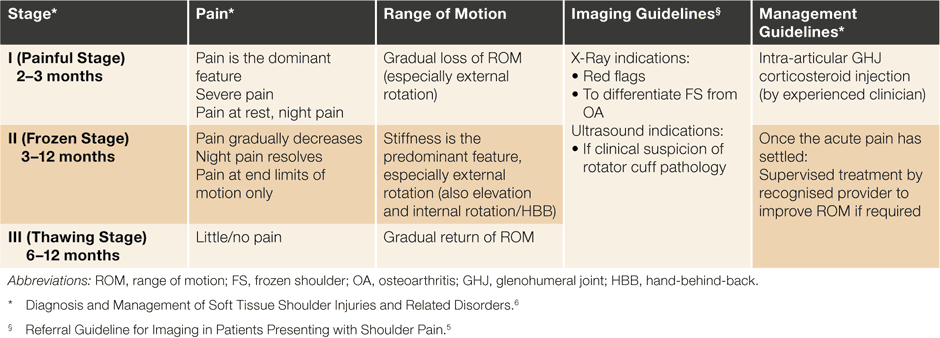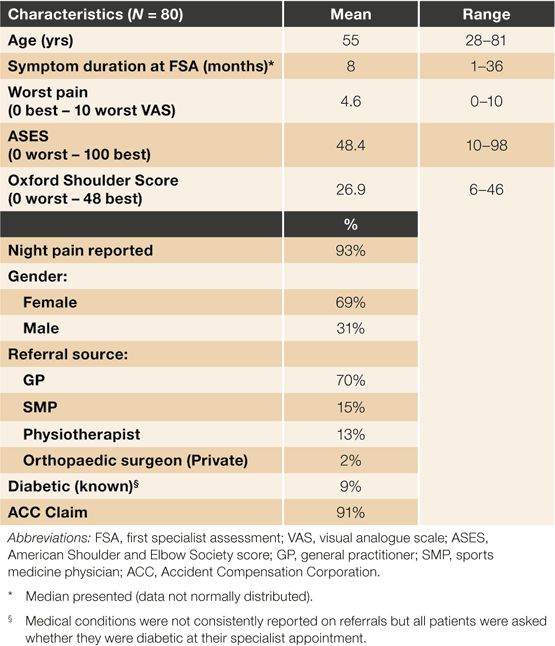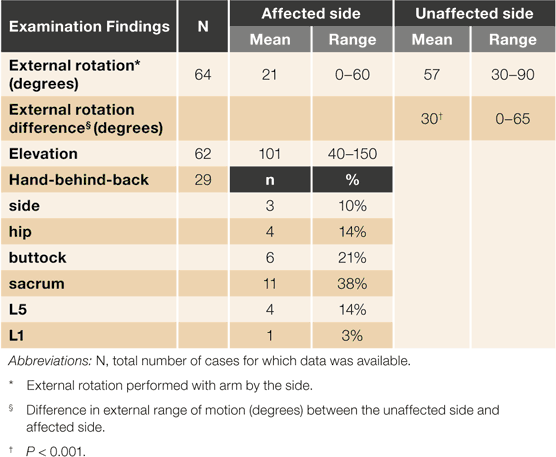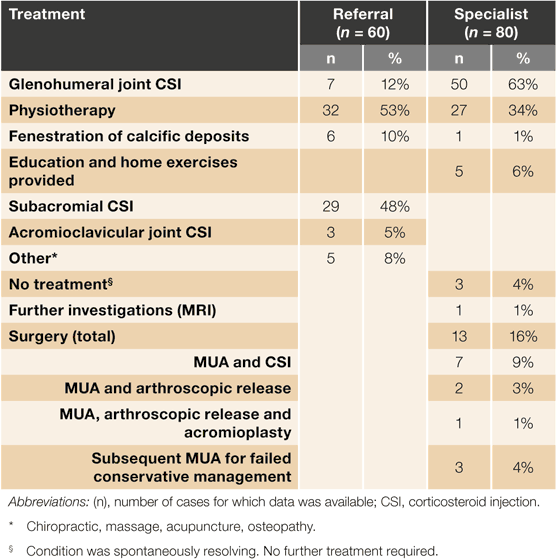Shoulder pain in primary care: frozen shoulder
Angela Cadogan 1 3 , Khalid D. Mohammed 21 Elmwood Orthopaedics, Christchurch, New Zealand
2 Department of Orthopaedic Surgery and Musculoskeletal Medicine, University of Otago, Dunedin, New Zealand
3 Correspondence to: Angela Cadogan Elmwood Orthopaedics, Specialists @ Eleven, 11 Caledonian Road, St Albans, Christchurch, New Zealand. Email: acadogan@vodafone.co.nz
Journal of Primary Health Care 8(1) 44-51 https://doi.org/10.1071/HC15018
Published: 31 March 2016
Journal Compilation © Royal New Zealand College of General Practitioners 2016.
This is an open access article licensed under a Creative Commons Attribution-NonCommercial-NoDerivatives 4.0 International License.
Abstract
BACKGROUND AND CONTEXT: Frozen shoulder is a painful condition that follows a protracted clinical course. We aim to review the management of patients with a diagnosis of frozen shoulder who are referred for specialist orthopaedic evaluation against existing guidelines in primary care.
ASSESSMENT OF PROBLEM: Referrals and clinical records were reviewed for all patients referred for orthopaedic specialist assessment who received a specialist diagnosis of frozen shoulder. Diagnostic, investigation and management practices from a regional primary health care setting in New Zealand were compared with guideline-recommended management.
RESULTS: Eighty patients with frozen shoulder were referred for orthopaedic evaluation in the 13 month study period, mostly from general practice. Fifteen patients (19%) were identified as having a frozen shoulder in their medical referral. Most (99%) had received previous imaging. Seven patients (12%) had received guideline recommended treatment.
STRATEGIES FOR IMPROVEMENT: Education of all clinicians involved in patient management is important to ensure an understanding of the long natural history of frozen shoulder and provide reassurance that outcomes are generally excellent. HealthPathways now include more information regarding diagnosis, imaging and evidence-based management for frozen shoulder.
LESSONS: Frozen shoulder may be under-diagnosed among patients referred for orthopaedic review. Ultrasound imaging is commonly used and may identify occult and unrelated pathology in this age-group. When managed according to clinical guidelines, patients report significant clinical and functional improvement with most reporting 80% function compared with normal after 1 year.
KEYWORDS: Adhesive capsulitis; bursitis; injections; practice guideline; primary health care; ultrasound
| WHAT GAP THIS FILLS |
| What we already know: Frozen shoulder is a clinical diagnosis characterised by a painful and gradual global loss of shoulder motion, including significant loss of external rotation with no other identifiable cause. The condition is more common in the diabetic population. Guideline-recommended treatment of frozen shoulder in Stage I (painful stage) includes an intra-articular glenohumeral joint injection of corticosteroid, followed by stretching and mobilisation in Stage II and III after the acute pain has subsided. |
| What this study adds: Frozen shoulder may be under-diagnosed among patients referred for orthopaedic review with many patients not receiving guideline-recommended treatment for the condition. There is a high number of imaging investigations performed that can reveal occult pathology un-related to the current symptoms of frozen shoulder. This places additional burden on imaging and orthopaedic services. |
Background
Frozen shoulder is a painful and disabling condition affecting 2–10% of the general population and up to 30% of people with diabetes.1 The prevalence is slightly higher in women (59–70%) with the mean age of onset being 50–55 years.2
Frozen shoulder is an inflammatory condition of unknown aetiology resulting in generalised glenohumeral joint synovitis with later development of a thickened, fibrotic joint capsule resulting in loss of joint motion. Frozen shoulder can be classified as primary frozen shoulder (idiopathic aetiology) or secondary ‘stiff’ shoulder (frozen shoulder associated with known disorders).2 Disorders known to be associated with a secondary ‘stiff’ shoulder include systemic conditions (e.g. diabetes mellitus), extrinsic factors (e.g. post-operative immobilisation or post minor trauma) and intrinsic factors (coexistent shoulder pathology e.g. calcific tendinosis).2,3
Frozen shoulder is defined by ‘the gradual development of global limitation of active and passive shoulder motion where radiographic findings other than osteopenia are absent’.2,3 The key diagnostic feature of this condition is painful loss of passive glenohumeral external rotation.2,4 Frozen shoulder follows a predictable clinical course that is characterised by three overlapping clinical stages (Table 1). The condition causes significant loss of upper limb function and can take between 1 and 3 years to resolve.1

|
In New Zealand, two clinical guidelines have been developed to aid in the diagnosis and management of patients with shoulder pain (Table 1).5,6 These guidelines align with other internationally-published guidelines for the diagnosis and management of frozen shoulder.4 In 2008 the Canterbury District Health Board also introduced ‘HealthPathways’, a website that provides general practice teams with guidance on the diagnosis and management of medical conditions (including musculoskeletal conditions) relevant to local services and resources.7
The number of referrals for orthopaedic assessment is increasing, often creating lengthy waiting times for initial consultations. The aim of this audit was to identify the number of patients with frozen shoulder referred from primary health care services to a private orthopaedic service, and to review the diagnostic and treatment information provided against existing clinical guidelines for frozen shoulder.
Assessment of problems
A clinical audit was performed on a prospective, consecutive patient cohort from a private orthopaedic practice specialising in shoulder conditions based in Christchurch, New Zealand. A retrospective review of referrals was conducted for all patients diagnosed with a frozen shoulder by the orthopaedic specialist at initial consultation between January 2013 and January 2014.
The diagnosis of frozen shoulder was made by the orthopaedic specialist according to current international consensus definition of the condition: a clinical presentation of limited active and passive external rotation combined with limitation to active and passive elevation and/or internal rotation (hand-behind-back) where significant glenohumeral joint pathology was absent on X-ray.2,3 Red flags including neurological features and pain referred from the cervical spine excluded the diagnosis of frozen shoulder. The diagnostic pathways and treatment interventions provided before specialist referral were reviewed against existing ACC guidelines.5,6
Results
Eighty patients aged 28–81 years (median 55 years) were diagnosed with frozen shoulder during the review period (Table 2): the condition was attributed to an episode of resorptive calcific tendinosis in 8 of these patients (10%). Clinical measures of range of motion used to make the clinical diagnosis of frozen shoulder are presented in Table 3.

|

|
Referral information
Information regarding onset of the condition, diagnosis and previous imaging is presented in Table 4. Frozen shoulder was recorded as the diagnosis in 15 of the 80 referrals (19%). The most common diagnosis stated on referrals was rotator cuff pathology (33%) and 99% of patients had undergone some form of imaging investigation before referral. Patients with a rotator cuff tear reported on ultrasound (49%) were 9 times more likely to have rotator cuff tear stated as the clinical diagnosis on referral (P < 0.001, 95% CI 3.1, 27.0) than patients with no tear reported. Previous treatments are presented in Table 5. An intra-articular glenohumeral injection had been administered before referral in 7 of the 80 patients (12%) diagnosed with frozen shoulder.

|

|
Specialist management
The specialist-directed management of patients with frozen shoulder followed the ACC guideline recommended-management according to the clinical stage of the condition (Table 5). Follow-up outcome scores were collected at a mean interval of 12.4 months following initial specialist consultation (range 6 to 19 months) with a response rate of 71% (Table 6). Results demonstrated considerable reduction in self-reported pain and improvement in function at ~1 year follow-up.

|
Strategies for quality improvement
Of the 80 patients diagnosed with frozen shoulder, only 15 (19%) were referred with the diagnosis of frozen shoulder but 99% had received imaging investigations, many of which were unlikely to influence clinical decisions regarding management. Only 12% had received guideline recommended treatment including an intra-articular glenohumeral corticosteroid injection. These results highlight several primary care issues regarding the diagnosis, use of imaging investigations, and management of frozen shoulder.
Clinical diagnosis
All patients exhibited the characteristic loss of passive range of motion associated with frozen shoulder, particularly in external rotation. It is possible that some patients were still in the early Stage I (Painful Stage) frozen shoulder at the time of presentation to primary care when loss of range of motion may not have been clinically evident. Clinical differentiation from other shoulder conditions can be difficult, contributing to under-diagnosis of frozen shoulder and the use of imaging in some cases.
Imaging
New Zealand imaging guidelines recommend a plain X-ray before other imaging investigations to help differentiate glenohumeral joint osteoarthritis from frozen shoulder and an ultrasound scan only if there is clinical suspicion of rotator cuff pathology.5 The high number of ultrasound scans requested before orthopaedic review suggests uncertainty regarding the clinical diagnosis, or clinical suspicion of rotator cuff pathology, or both. Ultrasound findings appear to have influenced the clinical diagnosis and subsequent treatment interventions, including the use of subacromial corticosteroid injections.
The correlation between imaging findings and clinical presentation is important for patients in this age group (mean age 55 years) in whom imaging reveals a high prevalence of asymptomatic shoulder pathology.8–11 The prevalence of asymptomatic rotator cuff tears is reported to increase from ~20% to 50% in people aged over 60 years,9,12 and may be more than 50% in people aged over 80 years.9,13 Subacromial bursal pathology, and evidence of bursal bunching on ultrasound are also common findings in patients with shoulder pain, reported respectively in 31% and 42% of patients with a variety of shoulder conditions in primary care.14 If imaging findings are not correlated with clinical presentations inappropriate treatment pathways may be taken.
In this cohort, frozen shoulder was identified as related to resorptive calcific tendinosis in eight patients (10%) based on clinical presentation and radiological findings, with subsequent evidence of reduction or disappearance of calcific deposits on follow-up X-rays. If the calcium crystals erupt into the glenohumeral joint ensuing inflammatory synovitis may result in a frozen shoulder.
Most patients (91%) diagnosed with frozen shoulder had a current Accident Compensation Corporation (ACC) claim in which the patient attributed the onset of symptoms to a traumatic event (Table 2). After an ACC claim has been lodged there is often pressure on health professionals to identify reasons for lack of response to conservative therapies (e.g. analgesics, NSAIDs and physiotherapy). Employers, the ACC, and patients often demand further investigations and referral for specialist assessments to identify structural pathology that may explain the severe and persistent symptoms and provide prognostic information to inform return-to-work timeframes. This may explain the high use of imaging, particularly ultrasound scans, and may also contribute to decisions to refer for orthopaedic evaluation.
Management
The management of frozen shoulder is determined by the clinical stage of the condition, with ACC guidelines recommending a glenohumeral joint corticosteroid injection and avoidance of aggressive mobilisation in Stage I (early, painful stage) followed, if required, by exercise supervised by a recognised treatment provider to improve range of motion in late Stage II and Stage III once the acute pain has settled (p19).15
Only 7 of the 80 patients (9%) had received a glenohumeral joint corticosteroid injection as part of primary care management compared with 48% identified as appropriate for a corticosteroid injection at the time of the specialist visit. Recognition of the diagnosis followed by provision of injections in the local community setting would assist in reducing costs to the health system, increasing accessibility to treatment for patients, and reducing orthopaedic waiting lists.
Outcomes
The outcomes of guideline recommended management administered by the specialist demonstrate a clinically significant reduction in patient self-reported pain and improvement in function.6 Median American Shoulder and Elbow Society Scores improved from 48 to 87 out of a maximum 100 (minimum clinically important difference 4–15).16,17 Using existing classification systems, changes in the Oxford Shoulder Scores resulted in patients being re-categorised from ‘poor’ (pre-intervention) to ‘excellent’ outcomes at 1-year follow-up.18 These results indicate a substantial improvement in pain and function in this group at 1 year follow-up, using guideline-based management.
A small number of patients reported an increase in pain and worsening function at 1-year follow-up. Although the clinical entity of frozen shoulder was the primary diagnosis at the time of first specialist assessment, many patients had co-existing shoulder pathology evidenced by ultrasound scan and MRI reports. It is possible that following treatment of the primary clinical condition of frozen shoulder, symptoms relating to underlying pathology may become evident that require additional management to improve patient pain and function.
When asked ‘how normal does your shoulder feel’, the median response at 1-year follow-up was 80%. This highlights the long-term course of this condition and aligns with other studies reporting that 50% of patients with frozen shoulder still experienced mild pain and stiffness at 2 to 11 years follow-up (mean 7 years).19 This result also highlights that, while the course of recovery is prolonged, most patients report good functional outcomes that may further improve beyond the 1-year follow-up period.
Recent evidence
Since the publication of the ACC Guidelines in 2004 further research and expert opinion has provided additional support for the use of corticosteroid injections for short-term pain relief and indicates that repeated injections can be beneficial (with a maximum of three).2 Important aspects of physiotherapy treatment are now reported to include patient education about the disease, a programme of pain-free home-exercises where patients are able to maintain a painless range of motion, followed by scapulothoracic re-training exercises to further reduce pain and restore shoulder girdle function in the later stages of the condition when the acute pain has settled.2,20–22
Educational initiatives
The authors have been involved in a recent review of the Canterbury District Health Board HealthPathways system including updating the guideline-recommendations for the management of frozen shoulder and links to a network of GPs and community-based physiotherapists who can (respectively) provide corticosteroid injections and physiotherapy services to patients in the local community. It is critical that patients and everyone involved in their care understand the natural history and associated time-frames for recovery, and are reassured that medium- to long-term outcomes are excellent in the majority of cases. This understanding may help avoid pressure on health practitioners to pursue unnecessary imaging investigations and specialist referrals.
Limitations
Some variables in this audit contained incomplete data. In the case of frozen shoulder, measures of range of motion are not routinely reported in referrals, making it difficult to ascertain the true extent of missed diagnosis given the evolving clinical picture of frozen shoulder.
Lessons
Frozen shoulder appears to be under-diagnosed among patients referred for orthopaedic review. Ultrasound imaging was commonly used in this patient group, possibly due to diagnostic uncertainty and pressure from patients and funders to find a structural cause of symptoms. Ultrasound scan reports of rotator cuff pathology may erroneously be interpreted as diagnostic in this age group, for whom rotator cuff changes on imaging are common and, in isolation, are not diagnostic. Management according to guideline recommendations was not implemented in many cases, possibly related to missed diagnosis or lack of awareness of guideline recommended treatment. Management according to clinical guidelines results in marked improvements in patient outcomes, with median return of 80% function after 1 year.
Improvements in diagnosis, thorough education of patients and clinicians as well as adherence to guideline-recommended management for frozen shoulder in primary care may assist in improving quality of patient care and patient outcomes, reducing health care costs and optimising specialist waiting times.
Conflicts of Interest
None declared.
References
[1] Arkkila PET, Kantola IM, Viikari JSA, Rönnemaa T. Shoulder capsulitis in type I and II diabetic patients: Association with diabetic complications and related diseases. Ann Rheum Dis 1996; 55 907–14.| Shoulder capsulitis in type I and II diabetic patients: Association with diabetic complications and related diseases.Crossref | GoogleScholarGoogle Scholar | 1:STN:280:DyaK2s7ms1yqtA%3D%3D&md5=d04cadb54c60dde3a899de305b798368CAS |
[2] ISAKOS Upper Extremity Committee. ISAKOS Upper Extremity Committee Consensus Statement: Shoulder Stiffness. Berlin: Springer-Verlag; 2014. Available from: http://www.google.co.nz/url?sa=t&rct=j&q=&esrc=s&source=web&cd=3&cad=rja&uact=8&ved=0CCYQFjACahUKEwiT4e2zqfDGAhVIJaYKHSYeC7E&url=http%3A%2F%2Flink.springer.com%2Fcontent%2Fpdf%2Fbfm%253A978-3-662-46370-3%252F1.pdf&ei=J2GwVdOxOMjKmAWmvKyICw&usg=AFQjCNGFKlDFNjpx53sP5uwUAY9QdalRaA&bvm=bv.98476267,d.dGY
[3] Zuckerman JD, Rokito A. Frozen shoulder: a consensus definition. J Shoulder Elbow Surg 2011; 20 322–5.
| Frozen shoulder: a consensus definition.Crossref | GoogleScholarGoogle Scholar | 21051244PubMed |
[4] Hanchard N, Goodchild L, Thompson J, O’Brien T, Davison D, Richardson C, et al. Evidence based clinical guidelines for the diagnosis, assessment and physiotherapy management of contracted frozen shoulder (Version 1.6, Standard Physiotherapy). 2011.
[5] The Accident Compensation Corporation. Referral Guideline for Imaging in Patients Presenting with Shoulder Pain. Wellington: The Accident Compensation Corporation; 2011.
[6] The Accident Compensation Corporation CGG. The Diagnosis and Management of Soft Tissue Shoulder Injuries and Related Disorders: Best Practice, Evidence-based Guideline. Wellington: The Accident Compensation Corporation; 2004. p. 1–67.
[7] McGeoch G, Anderson I, Gibson J, Gullery C, Kerr D, Shand B. Consensus pathways: evidence into practice. N Z Med J 2015; 128 86–96.
| 25662382PubMed |
[8] De Maeseneer M, Van Roy F, Lenchik L, Shahabpour M, Jacobson J, Ryu KN, et al. CT and MR arthrography of the normal and pathologic anterosuperior labrum and labral-bicipital complex. Radiographics 2000; 20 67–81.
| CT and MR arthrography of the normal and pathologic anterosuperior labrum and labral-bicipital complex.Crossref | GoogleScholarGoogle Scholar |
[9] Milgrom C, Schaffler M, Gilbert S, van Holsbeeck M. Rotator-cuff changes in asymptomatic adults. The effect of age, hand dominance and gender. J Bone Joint Surg Br 1995; 77 296–8.
| 1:STN:280:DyaK2M3itFCksQ%3D%3D&md5=a63dc8827fe55e048b321309dd9b1a6fCAS | 7706351PubMed |
[10] Sammarco VJ. Os acromiale: Frequency, anatomy, and clinical implications. J Bone Joint Surg Am 2000; 82 394–400.
| 1:STN:280:DC%2BD3c7os1yhtA%3D%3D&md5=bb2ee1e6fb7747b9ca93bc119042cddaCAS | 10724231PubMed |
[11] Shubin Stein BE, Wiater JM, Pfaff HC, Bigliani LU, Levine WN. Detection of acromioclavicular joint pathology in asymptomatic shoulders with magnetic resonance imaging. J Shoulder Elbow Surg 2001; 10 204–8.
| Detection of acromioclavicular joint pathology in asymptomatic shoulders with magnetic resonance imaging.Crossref | GoogleScholarGoogle Scholar |
[12] Sher JS, Uribe JW, Posada A, Murphy BJ, Zlatkin MB. Abnormal findings on magnetic resonance images of asymptomatic shoulders. J Bone Joint Surg Am 1995; 77 10–5.
| 1:STN:280:DyaK2M7it1GmtQ%3D%3D&md5=ceb13ab60021447984d8ff67887208a9CAS | 7822341PubMed |
[13] Tempelhof S, Rupp S, Seil R. Age-related prevalence of rotator cuff tears in asymptomatic shoulders. J Shoulder Elbow Surg 1999; 8 296–9.
| Age-related prevalence of rotator cuff tears in asymptomatic shoulders.Crossref | GoogleScholarGoogle Scholar | 1:STN:280:DyaK1MvgtFaiug%3D%3D&md5=279775e6cb17592af9d0e486af7a4cbdCAS | 10471998PubMed |
[14] Cadogan A, Laslett M, Hing WA, McNair PJ, Coates MH. A prospective study of shoulder pain in primary care: Prevalence of imaged pathology and response to guided diagnostic blocks. BMC Musculoskelet Disord 2011; 12 119
| A prospective study of shoulder pain in primary care: Prevalence of imaged pathology and response to guided diagnostic blocks.Crossref | GoogleScholarGoogle Scholar | 21619663PubMed |
[15] Goldberg BA, Scarlat MM, Harryman DT. Management of the stiff shoulder. J Orthop Sci 1999; 4 462–71.
| Management of the stiff shoulder.Crossref | GoogleScholarGoogle Scholar | 1:STN:280:DC%2BD3c7jtFSmtw%3D%3D&md5=7e1590b3a93834dbebb088a906cbbc9dCAS | 10664431PubMed |
[16] Michener LA, McClure PW, Sennett BJ. American Shoulder and Elbow Surgeons standardized shoulder assessment form, patient self-report section: Reliability, validity, and responsiveness. J Shoulder Elbow Surg 2002; 11 587–94.
| American Shoulder and Elbow Surgeons standardized shoulder assessment form, patient self-report section: Reliability, validity, and responsiveness.Crossref | GoogleScholarGoogle Scholar | 12469084PubMed |
[17] Tashjian RZ, Deloach J, Green A, Porucznik CA, Powell AP. Minimal clinically important differences in ASES and Simple Shoulder Test scores after non-operative treatment of rotator cuff disease. J Bone Joint Surg Am 2010; 92 296–303.
| Minimal clinically important differences in ASES and Simple Shoulder Test scores after non-operative treatment of rotator cuff disease.Crossref | GoogleScholarGoogle Scholar | 20124055PubMed |
[18] Kalairajah Y, Azurza K, Hulme C, Molloy S, Drabu KJ. Health outcome measures in the evaluation of total hip arthroplasties—A comparison between the Harris Hip Score and the Oxford Hip Score. J Arthroscopy. 2005; 20 1037–41.
| Health outcome measures in the evaluation of total hip arthroplasties—A comparison between the Harris Hip Score and the Oxford Hip Score.Crossref | GoogleScholarGoogle Scholar |
[19] Shaffer B, Tibone JE, Kerlan RK. Frozen shoulder. A long-term follow-up. J Bone Joint Surg. 1992; 74 738–46.
| 1:STN:280:DyaK38zisFWjsA%3D%3D&md5=2fe82fdb84fc60b582f50d6f583374a5CAS | 1624489PubMed |
[20] Camarinos J, Marinko L. Effectiveness of manual physical therapy for painful shoulder conditions: A systematic review. J Manual Manip Ther 2009; 17 206–15.
| Effectiveness of manual physical therapy for painful shoulder conditions: A systematic review.Crossref | GoogleScholarGoogle Scholar |
[21] Cleland J, Durall CJ. Physical therapy for adhesive capsulitis: Systematic review. Physiotherapy 2002; 88 450–7.
| Physical therapy for adhesive capsulitis: Systematic review.Crossref | GoogleScholarGoogle Scholar |
[22] Favejee MM, Huisstede BMA, Koes BW. Frozen shoulder: The effectiveness of conservative and surgical interventions-systematic review. Br J Sports Med 2011; 45 49–56.
| Frozen shoulder: The effectiveness of conservative and surgical interventions-systematic review.Crossref | GoogleScholarGoogle Scholar | 1:STN:280:DC%2BC3M%2FkvFKksQ%3D%3D&md5=6bcef4da76c8c68dd444ace9102bd2a4CAS | 20647296PubMed |


